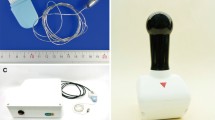Abstract
Background
Magnetic endoscopic imagers (MEIs) are being introduced during colonoscopy, principally for training. They aid recognition and resolution of loops. This has potential to improve technique resulting in increased completion rates and better patients’ experience.
Objective
To determine whether the use of a MEI improves colonoscopists’ performance.
Design
Cohort study.
Settings
Endoscopy unit in a district general hospital.
Patients
Consecutive patients undergoing colonoscopy during a 33 month period were studied.
Intervention
Patients underwent colonoscopy with or without the use of a magnetic endoscopic imager.
Main outcome measures
Patient comfort and colonoscopy completion rates with and without the use of a magnetic endoscopic imager. Other data recorded included sedation and analgesia doses, patient age and gender, bowel preparation quality, antispasmodic dose, time of day, and consciousness level.
Results
A total of 5,879 colonoscopies were performed. A magnetic endoscopic imager was used for 4,873. A greater proportion of patients in the imager group had the lowest discomfort score (56.2 vs. 39.8 %, logistic regression; p = 0.005). Doses of midazolam were similar in both groups (1.93 vs. 2.14 mg for imager and nonimager groups respectively). Completion rates were 94.5 % with an imager and 91 % without (logistic regression; p = 0.088). Logistic regression analysis showed that buscopan improved completion rate but detrimental factors included increasing patient age, discomfort, poor bowel preparation, and an afternoon procedure. Factors not influencing completion included gender, sedation and analgesia doses, and consciousness level. There was no correlation between documented reason for failure and use of the imager.
Limitations
This was a nonrandomized trial although improved with logistic regression analysis.
Conclusions
Magnetic endoscopic imager use improves patient comfort during colonoscopy but has not been shown to improve completion.

Similar content being viewed by others
References
Selehi S, Leung E, Wong L (2008) Factors affecting outcomes in colonoscopy. Gastroenterol Nurs 31:56–63
Colonoscopy JAG Trainee Certification Process (2011). www.thejag.org.uk/AboutUs/DownloadCentre.aspx
Hoff G, Bretthauer M, Dahler S, Huppertz-Hauss G, Sauar J, Paulsen J, Seip B, Moritz V (2007) Improvement in caecal intubation rate and pain reduction by using 3-dimensional magnetic imaging for unsedated colonoscopy: a randomized trial of patients referred for colonoscopy. Scand J Gastroenterol 42:885–889
von Elm E, Altman DG, Egger M, Pocock SJ, Gøtzsche PC, Vandenbroucke JP (2007) The Strengthening the Reporting of Observational Studies in Epidemiology (STROBE) statement: guidelines for reporting observational studies. Ann Intern Med 147:573–577
Ramakrishnan S, Yiannakou JY, Ellis WR, Bain IM (2004) Assessment of patient pain at colonoscopy: are nurses better than endoscopists? J R Soc Med 97:432–433
Shah SG, Brooker JC, Thapar C, Suzuki N, Williams CB, Saunders BP (2002) Effect of magnetic endoscope imaging on patient tolerance and sedation requirements during colonoscopy: a randomized controlled trial. Gastrointest Endosc 55:832–837
Bowles CJA, Leicester R, Romaya C, Swarbrick E, Williams CB, Epstein O (2004) A prospective study of colonoscopy practice in the UK today: are we adequately prepared for national colorectal cancer screening tomorrow? Gut 53:277–283
Harewood GC (2005) Relationship of colonoscopy completion rates and endoscopist features. Dig Dis Sci 50:47–51
Thomas-Gibson S, Thapar C, Shah SG, Saunders BP (2002) Colonoscopy at a combined district general hospital and specialist endoscopy unit: lessons from 505 consecutive examinations. J R Soc Med 95:194–197
Wells CD, Heigh RI, Sharma VK, Crowell MD, Gurudu SR, Leighton JA, Mattek N, Fleischer DE (2007) Comparison of morning versus afternoon cecal intubation rates. BMC Gastroenterol 7:19
Oh SY, Sohn CI, Sung IK, Park DI, Kang MS, Yoo TW, Park JH, Kim HJ, Cho YK, Jeon WK, Kim BI (2007) Factors affecting the technical difficulty of colonoscopy. Hepatogastroenterology 54:1403–1406
Shah HA, Paszat LF, Saskin R, Stukel TA, Rabeneck L (2007) Factors associated with incomplete colonoscopy: a population-based study. Gastroenterology 132:2297–2303
Rathgaber SW, Wick TM (2006) Colonoscopy completion and complication rates in a community gastroenterology practice. Gastrointest Endosc 64:556–562
Hsieh Y-H, Kuo C-S, Tseng K-C, Lin H-J (2008) Factors that predict cecal insertion time during sedated colonoscopy: the role of waist circumference. J Gastroenterol Hepatol 23:215–217
Anderson JC, Messina CR, Cohn W, Gottfried E, Ingber S, Bernstein G, Coman E, Polito J (2001) Factors predictive of difficult colonoscopy. Gastrointest Endosc 54:558–562
Nelson DB, McQuaid KR, Bond JH, Lieberman DA, Weiss DG, Johnston TK (2002) Procedural success and complications of large-scale screening colonoscopy. Gastrointest Endosc 55:307–314
Lieberman DA, Weiss DG, Bond JH, Ahnen DJ, Garewal H, Chejfec G (2000) Use of colonoscopy to screen asymptomatic adults for colorectal cancer. Veterans Affairs Cooperative Study Group 380. N Engl J Med 20(343):162–168
Aslinia F, Uradomo L, Steele A, Greenwald BD, Raufman J-P (2006) Quality assessment of colonoscopic cecal intubation: an analysis of 6 years of continuous practice at a university hospital. Am J Gastroenterol 101:721–731
Dafnis G, Granath F, Påhlman L, Hannuksela H, Ekbom A, Blomqvist P (2001) The impact of endoscopists’ experience and learning curves and interendoscopist variation on colonoscopy completion rates. Endoscopy 33:511–517
Radaelli F, Meucci G, Sgroi G, Minoli G (2008) Technical performance of colonoscopy: the key role of sedation/analgesia and other quality indicators. Am J Gastroenterol 103:1122–1130
Disclosures
Mr. Wood, Mr. Foy, Dr. Valori, Miss Lucarotti, Mr. Fowler, Mr. Dowler, and Mr. Cook have no conflict of interest or financial ties to disclose.
Funding
Nil.
Author information
Authors and Affiliations
Corresponding author
Rights and permissions
About this article
Cite this article
Wood, J.J., Foy, C.J.W., Valori, R. et al. Does use of a colonoscopy imaging device improve performance? A cohort study. Surg Endosc 26, 3616–3621 (2012). https://doi.org/10.1007/s00464-012-2384-3
Received:
Accepted:
Published:
Issue Date:
DOI: https://doi.org/10.1007/s00464-012-2384-3




